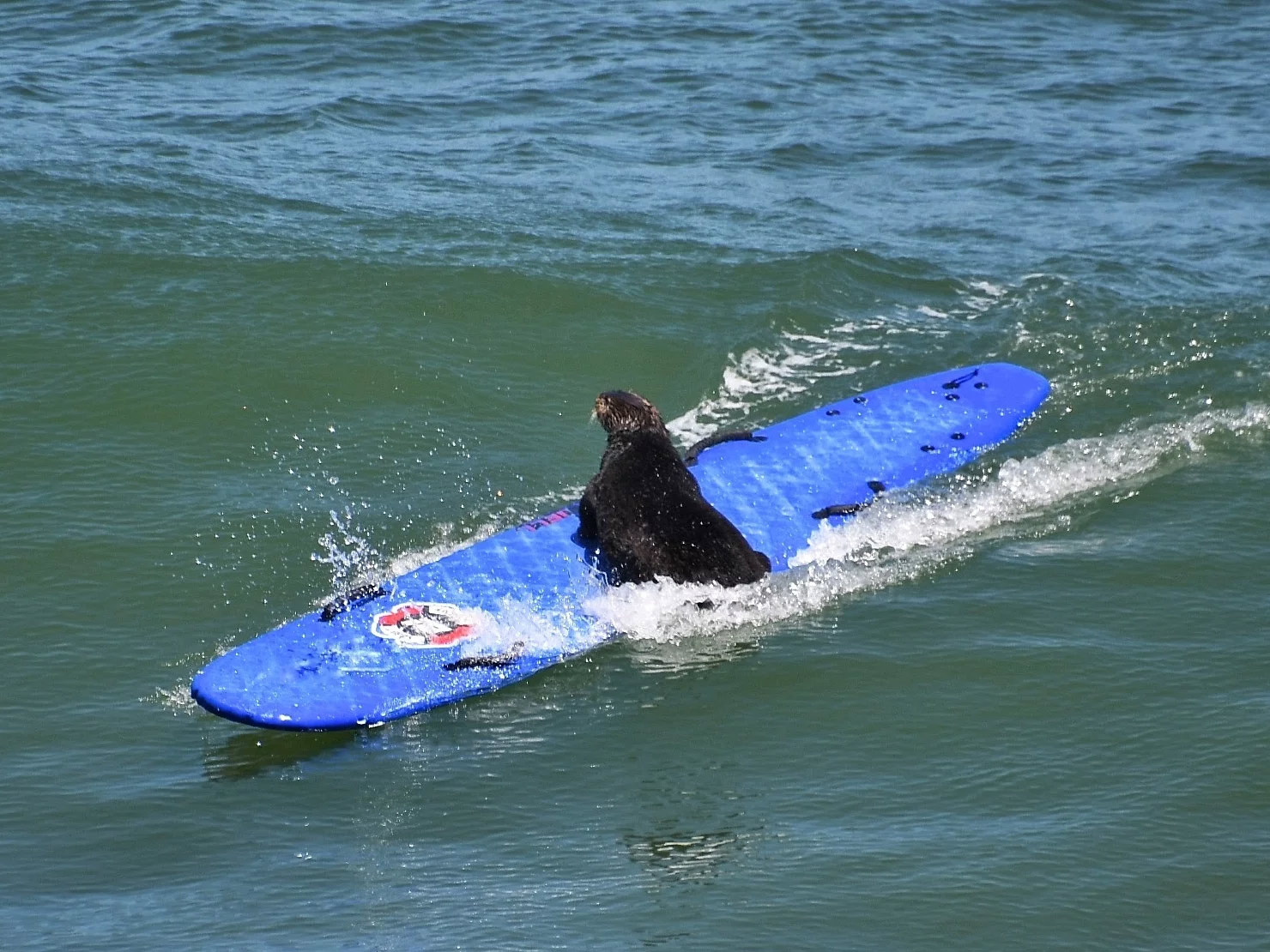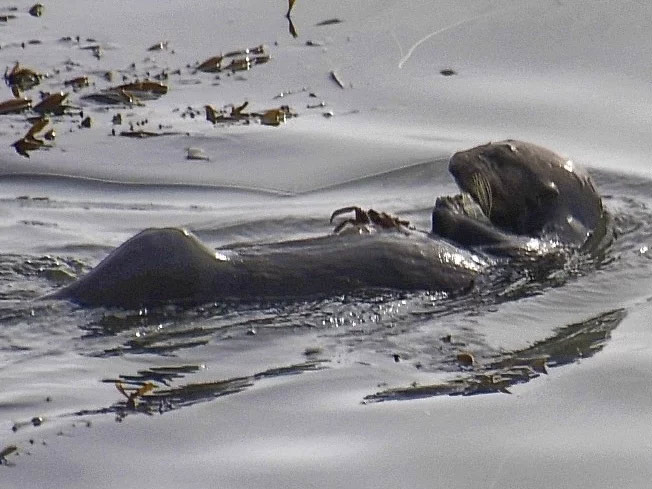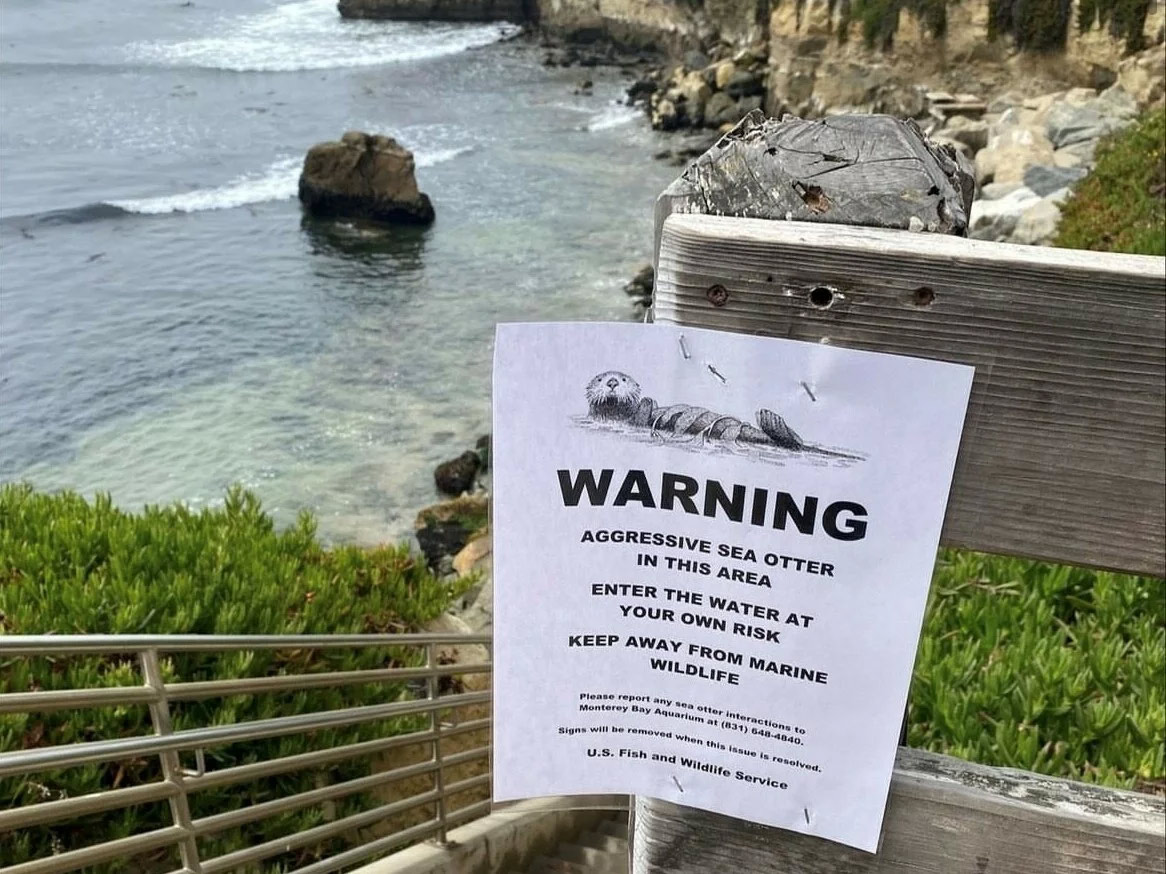 VIEW LARGER A southern otter in Santa Cruz, Calif., catches a wave after stealing a surfer's board.
VIEW LARGER A southern otter in Santa Cruz, Calif., catches a wave after stealing a surfer's board. Videos across social media show the otter hoisting itself out of the ocean and onto boards while surfers sit back in awe. At times she's chewed on the boards or forced surfers to surrender their boards altogether.
Onlookers in the videos can be heard laughing in jest at surfers' misfortune, but officials with the U.S. Fish and Wildlife Service say the otter poses a public safety risk.
"While there have been no confirmed reports of injury, due to the highly unusual behavior of this otter, kayakers, surfers, and others recreating in the area should not approach the otter or encourage the otter's interactions," the USFWS said in a statement.
 VIEW LARGER An otter at a popular surf break in Santa Cruz has been confronting surfers, going as far as stealing their boards and riding waves.
VIEW LARGER An otter at a popular surf break in Santa Cruz has been confronting surfers, going as far as stealing their boards and riding waves. Sixty-year-old Santa Cruz native and photographer Mark Woodward said he has photographed hundreds of otters over the years, but has never seen something like this. He's witnessed the otter bully surfers three times in less than a week.
"I saw the first incident on June 18 and I didn't know what was happening," Woodward told NPR. "... It was quite astounding."
The USFWS said the otter's behavior is "concerning and unusual," and though the exact cause is unknown, officials said it could be associated with hormonal surges or being fed by humans.
 VIEW LARGER The otter at Steamer Lane will live out the rest of its life in captivity once caught by the USFWS and aquarium staff. She's no longer afraid of humans, and if the otter were to bite or harm a person, she would have to be euthanized.
VIEW LARGER The otter at Steamer Lane will live out the rest of its life in captivity once caught by the USFWS and aquarium staff. She's no longer afraid of humans, and if the otter were to bite or harm a person, she would have to be euthanized. Southern sea otters are listed as threatened under the Endangered Species Act and are protected under the Marine Mammal Act as well as California law, the USFWS said. After being hunted to near extinction for their fur in the 1700s and 1800s, the population has rebounded since becoming a protected species and is a key predator in California's coastal ecosystems.
A team from the California Department of Fish and Wildlife (CDFW) and the Monterey Bay Aquarium is looking for the otter to catch and rehome her. Unfortunately once the otter is caught, Monterey Bay Aquarium spokesperson Kevin Connor told NPR, she won't be able to return to the wild.
The animal, officially known as otter 841, was born in captivity — because it's mother had also been too friendly with humans — and then successfully released into the wild in June 2020, Connor told NPR. It wasn't until September 2022 that she started exhibiting her bizarre behavior at Steamer Lane.
At the time, CDFW and aquarium staff were able to drive the animal out of the area, a process called hazing, in hopes of deterring her from interacting with people. But her most recent interactions show she's no longer afraid of humans, Connor said.
"Trying to recapture the otter is an effort to avoid anything more drastic. If the otter were to harm or bite a person, the USFW, which is responsible for managing the population of these animals, would have to begin discussions of euthanizing the animal," Connor said. "That's the reality, and nobody wants to see that."
 VIEW LARGER The southern sea otter was believed to be extinct until a family of 50 was found in Big Sur in 1938. Since being labeled an endangered species, they have bounced back from near extinction
VIEW LARGER The southern sea otter was believed to be extinct until a family of 50 was found in Big Sur in 1938. Since being labeled an endangered species, they have bounced back from near extinction Once caught, she will be taken to the aquarium for an exam before being moved into her forever home at an USFWS-approved location. Like her mother before her, otter 841 has been deemed un-releasable, Connor said.
The southern sea otter was believed to be gone forever, until a family of 50 were found in Big Sur in 1938, Connor said. Today, they number approximately 3,000, a mere 30% of what scientists believe the original population was before their near brush with extinction.
 VIEW LARGER The Santa Cruz Police Department warned locals about an ill-tempered southern sea otter confronting people at a popular surf spot known as Steamer Lane along West Cliff Drive.
VIEW LARGER The Santa Cruz Police Department warned locals about an ill-tempered southern sea otter confronting people at a popular surf spot known as Steamer Lane along West Cliff Drive. 
By submitting your comments, you hereby give AZPM the right to post your comments and potentially use them in any other form of media operated by this institution.